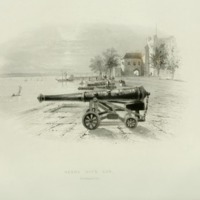Description
Remarking on the changes between Southampton of the 1620s and the city in the 1850s, William Henry Bartlett provides an illustration of a ‘curious old cannon, presented to the town by Henry VIII’ which overlooks the stop where the ‘"Mayflower" and "Speedwell," most probably, took in their passengers’. The cannon can still be seen to this day, now situated in the gardens of the Tudor House Museum, Bugle Street, Southampton. As Bartlett describes it:
"At the present day, Southampton is a gay, thriving town, about half divided between the pm-suits of pleasure and business. It is the head-quarters of the Royal Yacht Club, and the station for the West India and other mail-steamers. It has far out-grown its original boundaries, but a large portion of its walls and gates are yet remaining, and a ramble round them will carry one back to the wars of the Middle Ages, and the time when the quaint-looking, high-sterned little Mayflower" took in her cargo for the shores of America. One of the old towers bears the name of Edward the Black Prince. Here is the venerable old chapel called "Godde's House," wherein were interred the conspirators against Henry VII whose parting scene is immortalized by Shakespeare, and which was appointed by Queen Elizabeth as a place of worship for the fugitive Protestants expelled from the Netherlands. On the bank above the river, at a spot called "The Platform," is a curious old cannon, presented to the town by Henry VIII. Standing a little in advance of the old walls, it overlooks the broad, beautiful river, at the very spot where the "Mayflower" and "Speedwell," most probably, took in their passengers; and, save the erection of a steamboat pier, the features of the scene are but very little changed during the two centuries that have since elapsed."

